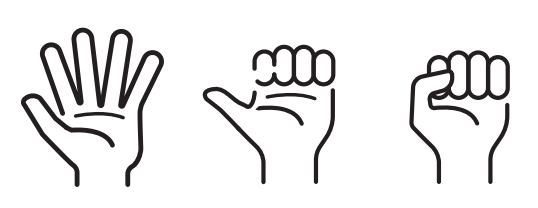Introduction
Our treatment of your hand injury is designed to restore normal function as soon as possible. Following the advice given in this leaflet should improve your symptoms. There is usually swelling following a hand or finger injury. This swelling should be reduced as soon as possible to prevent complications and help with pain relief.
It is also important to attend any follow up appointments that have been arranged.
Treatment Options
- Elevation: Elevation of an injured hand in a sling gets the swelling down quicker and helps in the recovery of your injured hand. The purpose of the high arm sling is to eliminate the effect of gravity and reduce the swelling. The clinician will advise you on how long to use the sling for. Use the sling when you are walking around. When sitting, you can remove the sling with your hand supported on pillows or cushions above your heart level ie as high as the opposite shoulder.
- Ice Therapy: Ice packs help to reduce the inflammation during the early stages
following an injury. It cools the area down and reduces swelling and bruising. Use a bag of frozen peas or crushed ice cubes placed in a plastic bag. Protect your skin from ice burns with a damp flannel or cloth. Place your cold pack on top of the painful area and wrap the towel or cloth around it to hold it in place. Never apply ice directly to the skin as this may result in an ice burn. An ice pack can be applied two or three times per day for 20 minutes, leaving two hours between applications. - Painkillers: You will probably need to take painkillers to reduce the pain you will experience. Paracetamol and Ibuprofen can be taken if you are able to (seek advice from the pharmacist, nurse or GP). Painkillers need to be taken regularly at the stated intervals for them to benefit you.
Exercise
The exercises in this leaflet are designed to help you improve your hand function following an injury

- Slowly clench your fingers into a fist. Hold for 10 seconds then straighten your fingers right out-repeat this 10 times.
- Stretch your fingers out sideways so there is a gap between each one and then press together, squeeze and then relax – repeat 10 times.
- Try and exercise your fingers as frequently as you can – at least every hour.
- The shoulder and elbow should be exercised (moved) at least 3 times a day
Splinting
Any splinting or strapping should feel comfortable and not too tight. They are meant to make you feel more comfortable. If the splint causes you pain, please attend the Minor Injury Unit or your local Emergency Department.
Follow up
If you have been given an appointment at the Hand Clinic, please ensure that you attend at the allotted time. Your symptoms should improve following this advice. If they do not improve, please return to the Minor Injury Unit.